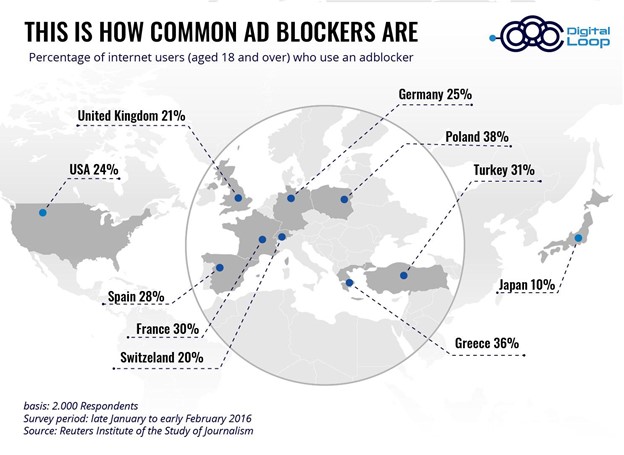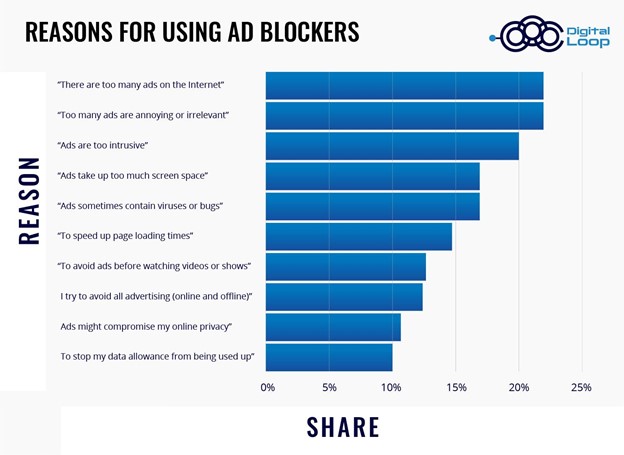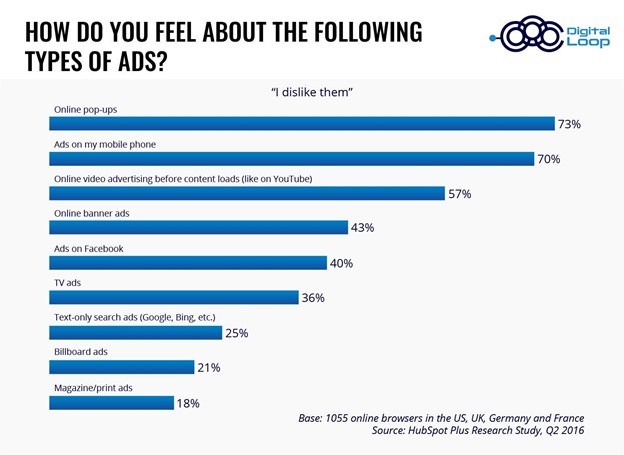Partner Content

Ad blockers are widespread these days and are used by many users. Today, 42.7% of internet users worldwide report using an ad blocker. And the technology has expanded beyond the desktop. Ad-blocking software for mobile devices and tablets is now widely available. According to a survey, 52% of adblock users have their blocker activated permanently, 32% of them deactivate it on selected pages to consume the entire content of a page and only 11% of adblock users use it selectively by activating it only on the most intrusive websites.
The following graphic shows the share of individuals who used ad blocking software in Germany in 2020, by device:
.png?width=614&name=download%20(8).png)
The use of ad blockers is increasing - desktop and mobile
Well-known AdBlockers are Adblock Plus, Adguard, and uBlock. They’re installed and activated as a browser extension. And the use of ad blockers via an app is also gaining ground on the smartphone market and mobile devices. Since 2015, Apple has even allowed ad blockers in the App Store. According to a report by PageFair, the number of downloads is increasing rapidly.
The use is understandable when website operators and app developers use an excessive number of ads and the content is full of banners; Layers and popups are completely lost from sight.

Source https://piwikpro.de/blog/wie-stark-adblocker-tracking-und-web-analytics-beeinflussen/
What effects do activated ad blockers have on your analytics data and tracking?
Anyone who has previously believed that an ad blocker is only a problem for the advertising industry, publishers, bloggers or affiliates, is seriously mistaken. Because most ad blockers not only block banners and advertising space, they also prevent web analysis! The user behaviour of a user with an activated ad blocker is no longer recorded.
But what are the most common reasons for using adblockers? Globally, the most commonly reported reasons for using ad blockers include excessive amounts of ads (22.3%), the irrelevance of ad messages (22.3%), and the intrusion factor (19.9%):

Source. https://www.hootsuite.com/resources/digital-trends
The rejection is particularly high for pop-ups (73%), mobile advertising (70%), and video interstitials (57%). On the other hand, print advertisements in magazines (18%) and OOH advertisements (21%) are rarely perceived as annoying, as this study shows:

Overall, 91 percent of those surveyed agreed that advertising is more intrusive today than it was two to three years ago. 83 percent say that not all ads are bad, but they want to be able to filter better. Additionally, 63 percent said most online ads didn't look professional, and 56 percent said the ads were offensive to users' intelligence. This is tough criticism.
Google Analytics does not track users with an activated ad blocker
Third party analytics tools such as Google Analytics and other SaaS providers do not operate the website themselves and are therefore susceptible to be blocked. Filippo Valsorda's example shows how much of a difference it makes. He compared the data tracking of Google Analytics with Matomo, a web analytics application that runs directly on one’s own webserver, and recorded 50% more page views in Matomo.
You can enter adblock users manually in Google Analytics afterward to determine your overall traffic and access numbers more precisely. This way, you can at least see how high the percentage of visitors with activated ad blockers is and how badly you are affected.
But what happens on the website, which macro and micro conversions these users achieve, which goals they complete, and which segments the users belong to you will have to do without this data.
Don't make decisions based on incomplete data
As mentioned at the beginning, an average of almost a third of all German Internet users have activated an ad blocker. Depending on age, target group, and industry, this value can, however, fluctuate very strongly. Both down and up. The more tech-savvy your target group, the more likely it’s that an ad blocker will be used. As a basic principle, one should always bear in mind that a high proportion of possible data that is important for further analysis is missing. You should ask yourself whether you want to make an important budget or company decision based on incomplete or even incorrect data. Think about how you can optimize the web analysis. As described above, you can examine how hard it hits your company. If you not only want to find out the severity of the "disease" but also want to reliably contain the disease, you should "vaccinate" your web analysis system. You can achieve this in the long term by switching to self-hosted analytics. To test and compare the system, you can also let both systems run in parallel for a transitional period. Like that, employees can slowly get used to the new tool.
How to master the adblocker challenges of web development and web design
Before ad blockers endanger the success of your web project, you should adapt your online presence to modern ad blockers. In Germany the cards are stacked against your project: According to a study by the Reuters Institute for the Study of Journalism, around one in four Germans uses an ad blocker. The highest proportion of adblock users, however, is in Poland with 38%, closely followed by Greece with 36% and Turkey and France with around 30% each. If your web project is aimed at one of these countries, this factor has to be taken into account.
Solutions for web projects without integrated advertising
In order not to mistakenly end up on the lists of filter add-ons, there is in principle a generally applicable, albeit time-consuming, method: explicitly differentiate your content from the usual display types and formats. You can do this both
- technically, for example by avoiding pop-up elements,
- as well as optically through a clear demarcation from advertising banners
Make it clear to adblockers that this is not advertising. To counteract the phenomenon of banner blindness at the same time, you should also never add important navigation or content elements to typical areas of your website. At this point, the right sidebar and the header should be mentioned, which are seen rather sporadically even without the action of an advertising filter. You should then regularly test if your website is in working order. The procedure is no different to typical A / B or multivariate tests. In test procedures for verifying the functionality of your web project, which are typically aimed at examining different screen sizes, resolutions, devices, and web browsers, you also simply take into account the effects of the most commonly used ad blockers.
Concerning the web analysis problem, there is also a simple solution. For WordPress projects, for example, there are tools such as BlockAlyzer that provide information on how many of your users have used an ad blocker. You can incorporate the result into the general statistics to get an overall picture of the actual conversion rate.
Conclusion: accept ad blockers as part of the online market
Lawsuits and legal proceedings against ad blocker manufacturers aren’t uncommon. But so far, except for minor triumphs such as the aforementioned judgment that financially adjustable whitelists are illegal, no serious successes have been achieved. Recognizing advertising filters as an integral part of what is happening online and reacting with appropriate countermeasures is therefore an important step for the success of your web project. Of course, you can design your website and all advertisements in such a way that ad blockers do not affect them. But on the one hand, this involves a lot of effort and, on the other hand, you face the large community of the respective filter add-on, which jointly creates new filter rules every day.
Falling prices for ads mean that the existing budget is better invested in more reach and not in more quality. It’s also popular, like e.g. AdBlock Plus, to give companies access to the user again by channelling the advertising through the AdBlocker. That ways companies would also have to pay the AdBlocker provider. Google is now also planning a very similar model for its browser.
The more elegant way is to find alternative advertising formats or income models that save users from the less appreciated banners and pop-ups, but still give you the income you want. Many website operators are now considering the idea of restricted or chargeable access as well as native advertising - i.e. the use of advertising that is designed like editorial or user-generated content. If you concentrate on strong content and are creative with the ad blocker topic, then your visitors will quickly be ready to switch off the add-on used or respond to your new strategy.
About Digital Loop
We at Digital Loop are the experts for your digital business. We provide companies with success-oriented recommendations for action, which are the base of Data Analysis. Data enables us to develop strategies to better position companies in the market. We work on the grounds of personal consulting and implement technical skills. Our goal is to gain insights into the customer’s journey and keep them on the long-term by using integrated marketing techniques and analytics. We are experts in SEO-, CRO-Marketing, Content and Tracking, Personalization, eCommerce, and Targeting. Since 2015 we’ve been successfully supporting numerous companies throughout Germany. Our goal always is to support companies to reach their best potential. Visit our website!
About John Munoz (CEO of Digital Loop and MarTech Specialist):
John has over 12 years of experience in Digital Analytics, MarTech, and Tech SEO. Besides that, he’s a Google Analytics and Adobe Analytics Expert. As the CEO of Digital Loop, he’s always the first point of contact regarding all topics.
Find him on LinkedIn
